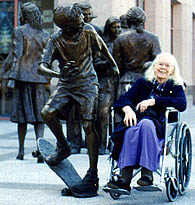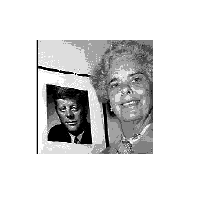 |
Trigger Point Therapy * PNF Stretches * Dr Janet Travell |
 | |
On 1 August, 1997, Janet Travell Powell died at the age of 95. She is remembered as the first woman physician to the President of the USA, serving both John Kennedy and Lyndon Johnson in office. Her major legacy is the two volume "Myofascial Pain and Dysfunction: The Trigger Point Manual" which she wrote with David Simons and Barbara Cummings. In it she mapped the distribution of hundreds of trigger points, a major cause of muscular pain. For much of her life the work was speculative: she could diagnose and she could treat but she could provide no acceptable explanation of the neurological processes involved. She was in her eighties when the breakthrough was finally made, and incorporated into a second edition of Volume 1, published shortly before she died. The effect of this was that for much of her life, her work was largely sidelined by most physiotherapy and medical training institutions. Only in the last 15 years or so has it begun to feature widely in training programmes. |
To quote the experts, a trigger point is " a hyper-irritable locus within a taut band of skeletal muscle, located in the muscular tissue and/or its associated fascia." The TP has a characteristic pattern of pain referral that does not follow segmental innervation. Briefly, it is a point in a muscle or ligament that can generate stiffness and or pain in a predictable pattern, often some distance from the point itself. I speak about potential, latent and active trigger points. A potential trigger point is the spot in a muscle or fascia where a trigger point will form if it is going to. With some exceptions, trigger points occur in predictable places in each muscle. A trigger point is a consequence of an accumulation of body responses to trauma - physical trauma, emotional or chemical trauma. One incident may not be enough to generate a trigger point, but it is like a deposit in a bank account. (Dr Travell specifically acknowledges the potential role of emotional history in causing physical pain.) As the effect of trauma accumulates in a potential trigger point it begins to generate an area of stiffness or mild pain, again in a predictable pattern and usually when the muscle is contracted. We now refer to it as a latent trigger point. The muscle begins to move more stiffly. It becomes weaker and loses some of its fine motor co-ordination. Sufferers notice that the pain or stiffness is usually worse when they first get up, and eases off after they have moved around a little. An active trigger point is one that is generating pain on a more or less continuous basis. The next feature of a trigger point is that it refers pain to the body in a predictable pattern that until the 1980's did not correspond to any conventional understanding of muscular innervation. It was not until the late 1980's that neurological research discovered the mechanism by which this occurred. This was reported in the Second Edition of volume 1, Travell and Simons, Myofascial Pain and Dysfunction. A point in the scalene muscle in the throat refers pain down the arm in a pattern very similar to OOS pain. A point in the back of the calf can refer pain to the side of the face. Points along the top of the pubic bone refer pain and stiffness to the lower back. These are extreme examples, but you get the idea. Secondary Trigger PointsOne complication of this is that if trigger point #2 is located in the pain pattern generated by trigger point #1, the pain is often sufficient to cause #2 to become active as well, and generate its pain pattern. Often, by the time a client reaches me, they have been in pain long enough for this to happen, and unravelling the pain chain can be quite a challenge. Treatment A physician trained in Dr Travell's techniques would employ a three pronged approach: an injection of local anaesthetic into the trigger point, a stretch of the muscle concerned combined with the application of either ice or an evaporant spray. This, though effective, is quite painful, and has a slight downside in that it destroys muscle tissue in the immediate vicinity of the trigger point. It also requires an extremely skilful use of a hypodermic. It also requires one to be appropriately licensed. I use finger or thumb pressure to reduce oxygen supply to the trigger point, in association with a gentle muscle or even trunk stretch assisted by the client breathing in as I stretch. This requires a few more visits as we are involved in muscle re-education as well as trigger point therapy. If the trigger points have been active for some time, habitual movement patterns may have developed which need to be addressed or the trigger points will simply reactivate. Myofascial Pain Syndrome and Fibromyalgia By the time they are forty years old it would be rare to find an adult who does not have a number of latent trigger points interfering with co-ordination, strength, suppleness, eyesight and so on. As I said, they are the accumulation of a half lifetime of insults and trauma, from the very minor bumps of childhood games to the life - threatening. Many people earn their living in jobs that set them up for trigger point injury - keyboard operators, carpenters, and so on. Smokers and workers with toxic chemicals, and those in high stress jobs are also affected. In all of the above, the muscular pain is the result of some external agent. Closely mimicking the symptoms of the above is a systemic condition called fibromyalgia. Here we are talking about a disease which affects the muscles in many of the same ways that latent and active trigger points do. Differential diagnosis is a matter for a physician trained in this area, though one can begin to get an idea by checking 18 diagnostic points on the body. If 11 or more of these are tender, a diagnosis of fibromyalgia is normally made. It is worth remembering, though, that doctors often experience pressure to favour a fibromyalgia diagnosis. The reason for this is that fibromyalgia is not a work-related condition, and does not entitle the sufferer to "compo". The heat comes off the employer. If in doubt, and if you believe that your work has contributed to your condition, it is worth seeking a second - or third - opinion. While I can generally obtain temporary relief for this condition using standard TP therapy, it is nearly always shortlived, and my in experience fibromyalgia responds more readily to a dietary regime under the supervision of a appropriate specialist. PNF stands for proprioceptive neuromuscular facilitation. In its classical form, a muscle is passively moved into full extension, and stabilised in that position by the therapist while the client attempts to contract it, usually for a period of about 7 seconds, continuing to breathe as he does so. As the client relaxes, the therapist may be able to move the muscle a little further into extension and the process is repeated. Any attempt by the client to recruit other muscles to assist in the contraction should be called immediately, and the client requested to use less effort. By the time a client seeks therapy he will be typically "using everything to do everything". It is one of the major foci of therapy to return to him his ability to identify, use and control much smaller groups of muscles, and in doing so recover some of the fine motor co-ordination that he will have lost. A large number of the muscles of such a client will normally be hypertonic. I have adapted the classic PNF stretch in a number of ways.
Among bodyworkers, the word "hypertonic" is used with a variety of quite different meanings. When I use it to describe a muscle I am referring to a muscle that is weaker than normal, shorter/tighter than normal, and lacking in ability to move precisely. It will normally contain a number of latent or active trigger points. I am not referring to a muscle which is tight because of an antagonist's lack of tone, but one which contains the seeds of its tightness in itself. Often both agonist and antagonist muscles will be hypertonic, in this sense of the word.
| ||